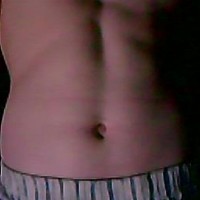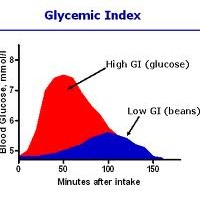When Portion Control Takes Control Of You
Snack attacks are the major pitfalls of a healthy diet - but portion size runs a close second. A serving size is the amount of food a person would normally eat at a single meal. Have you been to a restaurant lately? Get a load of their portion sizes!
Calorie counts are based on serving size, so knowing what a true portion size should be is a huge component of healthy weight loss. You won't always have a nutrition label to read whenever you eat, so measure out your servings religiously when you eat at home. Once you know what a serving size should be, it will be easier to eat correctly when you're away from home.
Essential tools in a weight loss kitchen are a food scale, measuring cups and measuring spoons. I don't know about you, but when I'm hungry, my guesses about portion size seems to get larger with my hunger! Measure your foods instead of guessing.
One way to control portion sizes is to NOT put bowls of food on the table. Fill your plates in the kitchen and then take them to the dining room to eat. This keeps food out of sight so that it's not as tempting to overeat.
The answer to "seconds" should be no! If you've planned your meals based on single servings and then go back for more, you're doomed to weight loss failure.
Scheduling meal times will help prevent those snack attacks discussed earlier. Also, if you are scheduling your meals, you're less likely to get that "starved" feeling and start shoveling in the food. That's a sure way to tempt yourself to disregard your allotted serving sizes. The best time to eat is when you're hungry but not starving.
How many meals should you eat in a day? The traditional number is three - breakfast, lunch and dinner. Most people eat much more than that. Doctors and nutritionists are now saying that five or six smaller meals is a better way to go. This is particularly true for people with diabetes. Eating smaller, more frequent meals keeps insulin levels from those dangerous highs and lows. It also controls that extreme hungry feeling that can cause overeating.
When you're eating your meal, eat slowly and savor the flavors. It takes about twenty minutes for your brain to send the message that you're not hungry anymore. If you rush through eating, you'll be consuming way more than you need to for that full feeling. I'm sure you've had that feeling of "I just can't eat one more bite!" That's the reason you've reached that point.
Keep track of what you eat by using a food diary. Note down what your portion sizes should have been and then what they actually were. How many additional calories did you consume? Were you "really" that hungry? Write down what your mood was or if you were under extra stress at the time you ate.
If you really must eat between your scheduled meals and snacks, choose a food that will fill you up but not fatten you up - such as fruit.
Regulating portion sizes is not as easy as it sounds but it is definitely worth the effort. Measure, measure, measure until your inner eye recognizes true portion sizes. Soon, you'll have lost that 20 (or however many) pounds that you wanted to lose.
Calorie counts are based on serving size, so knowing what a true portion size should be is a huge component of healthy weight loss. You won't always have a nutrition label to read whenever you eat, so measure out your servings religiously when you eat at home. Once you know what a serving size should be, it will be easier to eat correctly when you're away from home.
Essential tools in a weight loss kitchen are a food scale, measuring cups and measuring spoons. I don't know about you, but when I'm hungry, my guesses about portion size seems to get larger with my hunger! Measure your foods instead of guessing.
One way to control portion sizes is to NOT put bowls of food on the table. Fill your plates in the kitchen and then take them to the dining room to eat. This keeps food out of sight so that it's not as tempting to overeat.
The answer to "seconds" should be no! If you've planned your meals based on single servings and then go back for more, you're doomed to weight loss failure.
Scheduling meal times will help prevent those snack attacks discussed earlier. Also, if you are scheduling your meals, you're less likely to get that "starved" feeling and start shoveling in the food. That's a sure way to tempt yourself to disregard your allotted serving sizes. The best time to eat is when you're hungry but not starving.
How many meals should you eat in a day? The traditional number is three - breakfast, lunch and dinner. Most people eat much more than that. Doctors and nutritionists are now saying that five or six smaller meals is a better way to go. This is particularly true for people with diabetes. Eating smaller, more frequent meals keeps insulin levels from those dangerous highs and lows. It also controls that extreme hungry feeling that can cause overeating.
When you're eating your meal, eat slowly and savor the flavors. It takes about twenty minutes for your brain to send the message that you're not hungry anymore. If you rush through eating, you'll be consuming way more than you need to for that full feeling. I'm sure you've had that feeling of "I just can't eat one more bite!" That's the reason you've reached that point.
Keep track of what you eat by using a food diary. Note down what your portion sizes should have been and then what they actually were. How many additional calories did you consume? Were you "really" that hungry? Write down what your mood was or if you were under extra stress at the time you ate.
If you really must eat between your scheduled meals and snacks, choose a food that will fill you up but not fatten you up - such as fruit.
Regulating portion sizes is not as easy as it sounds but it is definitely worth the effort. Measure, measure, measure until your inner eye recognizes true portion sizes. Soon, you'll have lost that 20 (or however many) pounds that you wanted to lose.
Related Articles
-
Swap Your Way Slim at Every Meal
-
A popular drug Phentermine is able to help you lose weight
If your physician advised you to get rid of weight because on it depen
-
Three Easy Ways To Reduce Weight – Do Exercise, Eat Healthy And Take Supplements
-
Fat Burning Furnace Reviews
Fat burning furnace reviews : Of all the weight loss program in the in
-
Understanding the Glycemic Index
Things get so confusing when it comes to understandi
-
How To Lose 21 Pounds & Keep Down Weight With 2 Crazy Tricks That Really Work In Just 3 Weeks!
CLICK HERE NOW to DOWNLOAD The Fat Burning Furnace Program and Lose 21
- DON'T MISS
- Weight Loss Pills - Why Choose Hoodia Diet Pills For Effective Weight Loss?
- Cheat Your Way Thin Pdf-Cheat Your Way Thin Review
- Gluten Free Diet
- Free Hypno-Band™ Seminar Jan. 29, 2011 in San Diego
- Diet free weight loss
- Propylene Oxide
- Is A Cleansing Diet A Good Way To Lose Weight?
- Should You Buy Pure Acai Berry or Fat Loss Pills For Fast Weight Loss?
- Does Joel Marion's Cheat Your Way Thin Program Works?
- Different Types and Kinds of Weight loss Exercises




